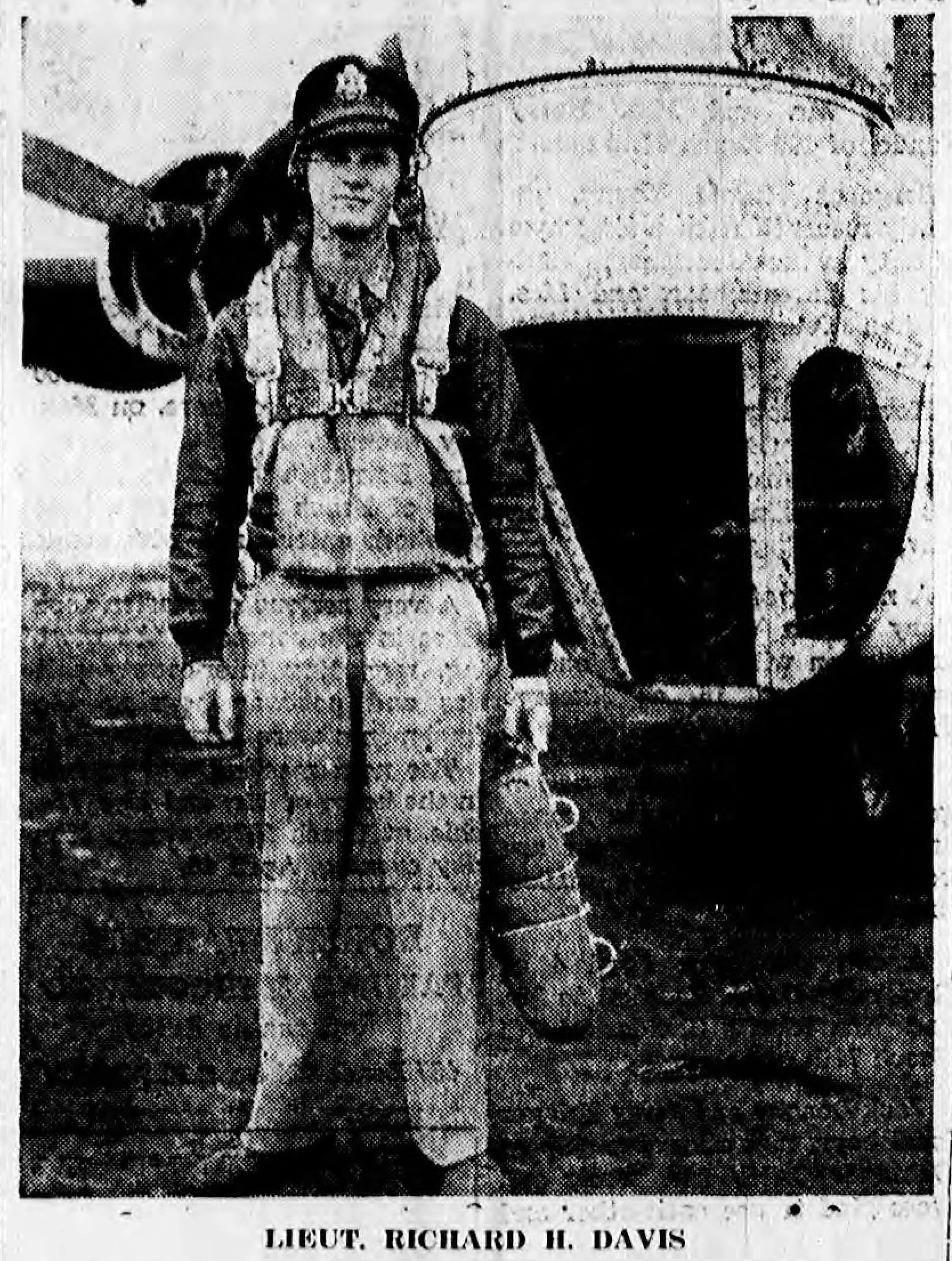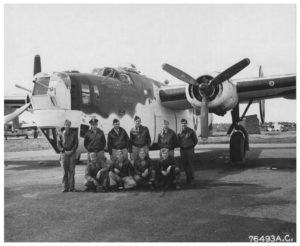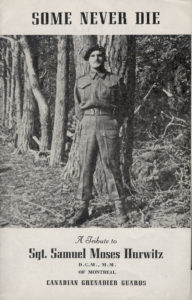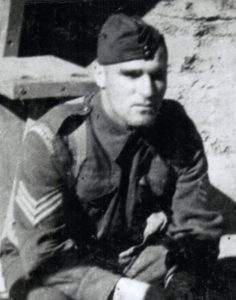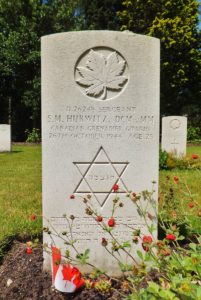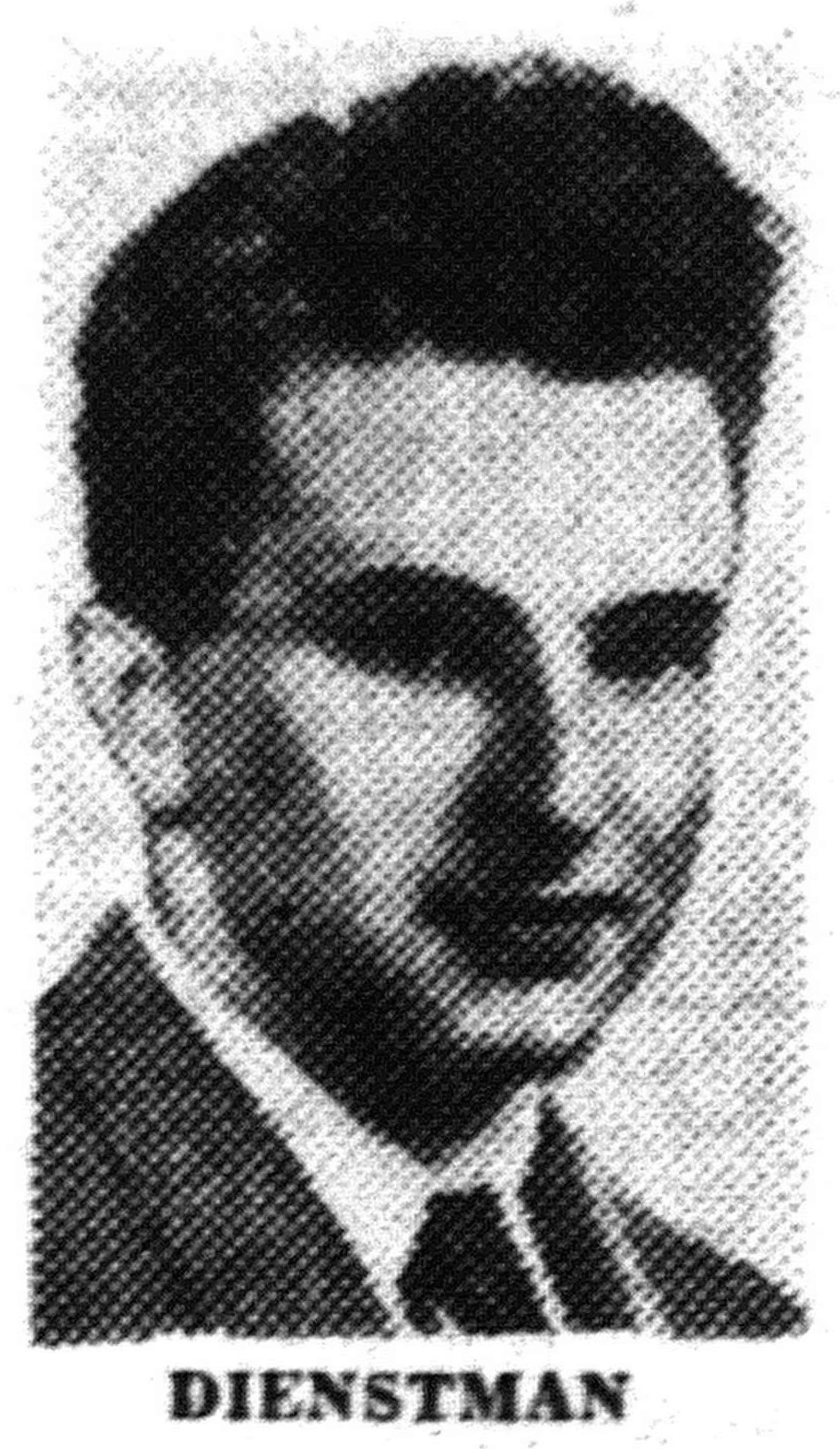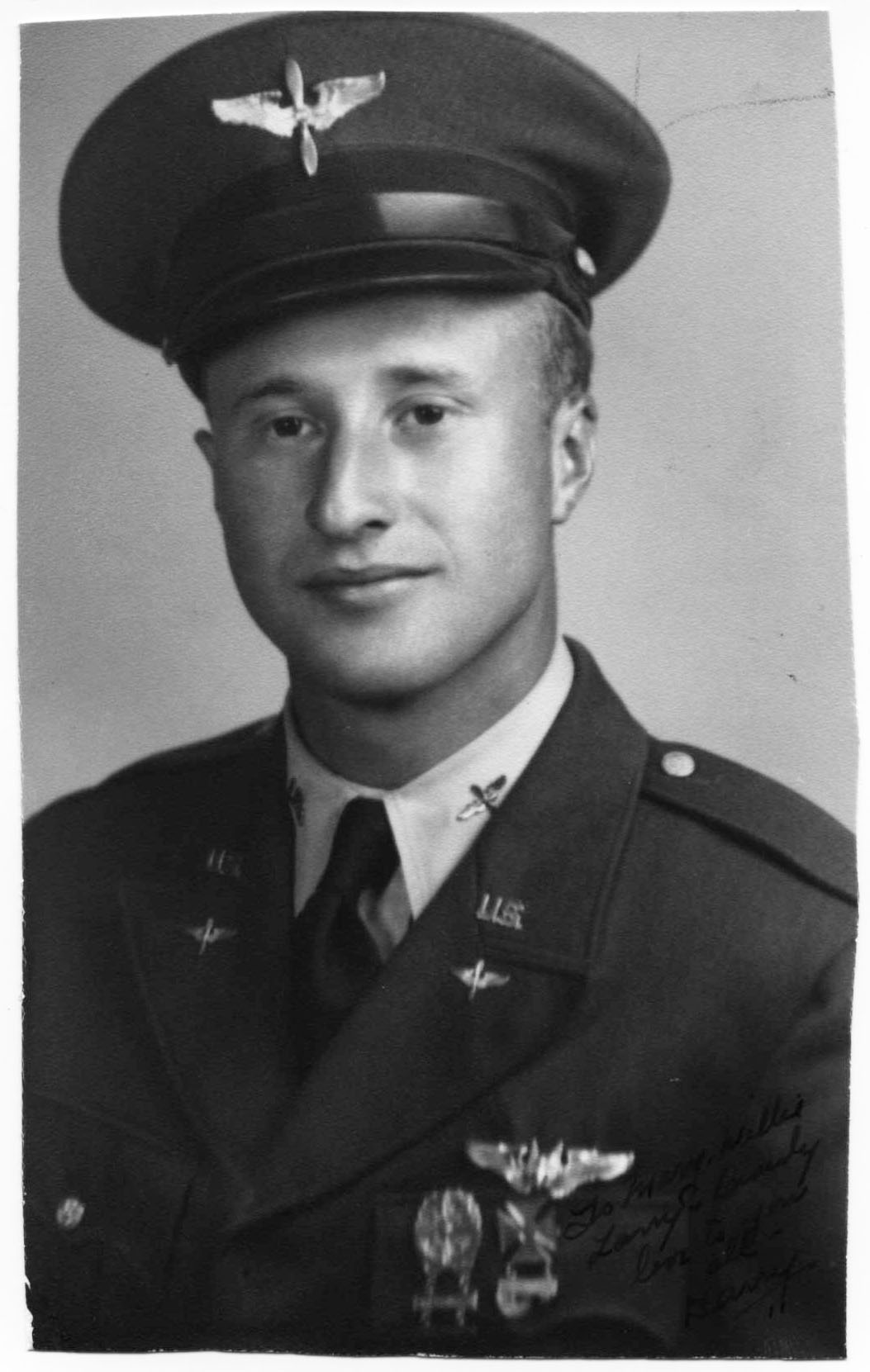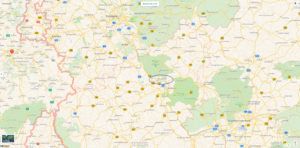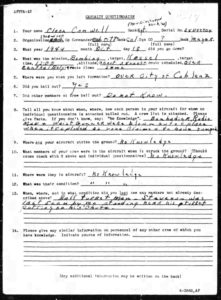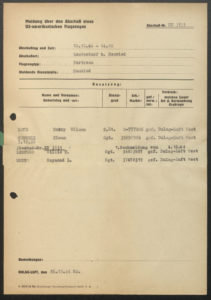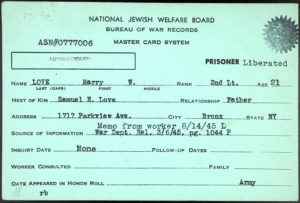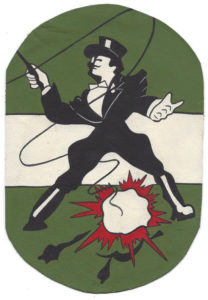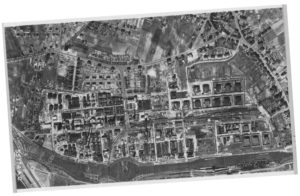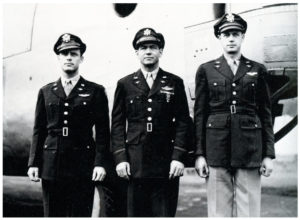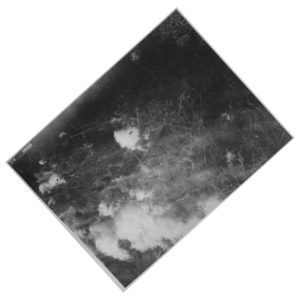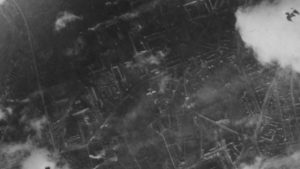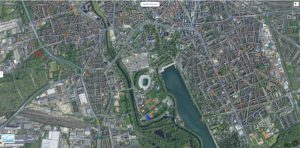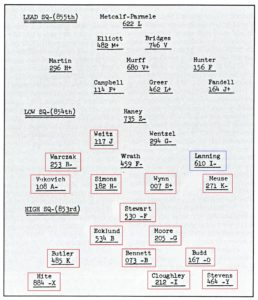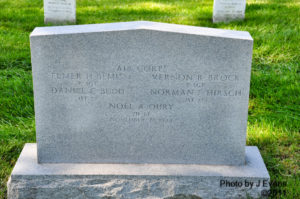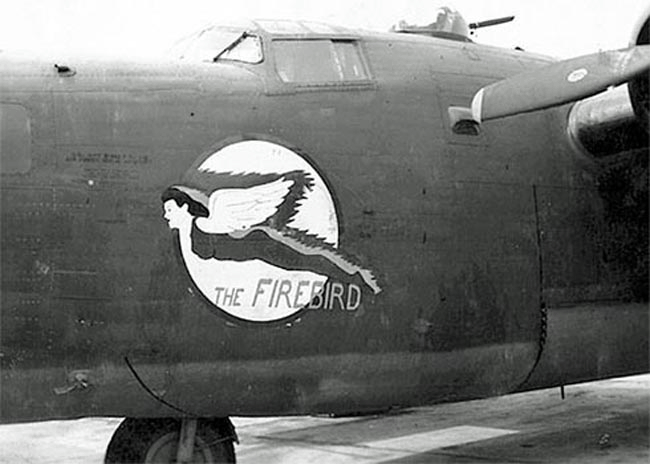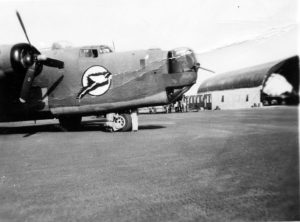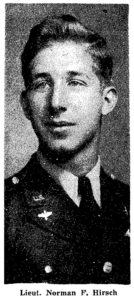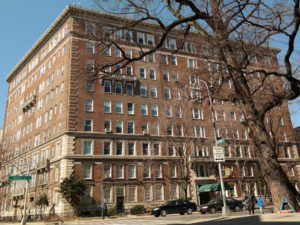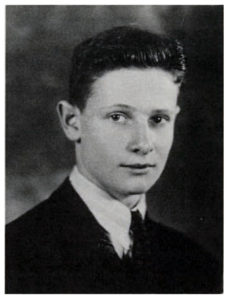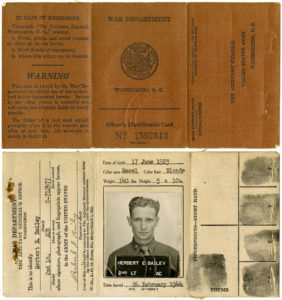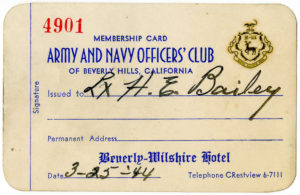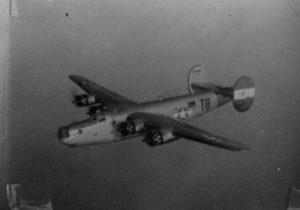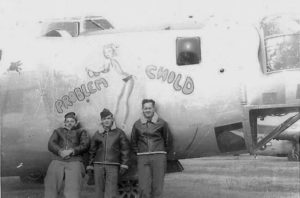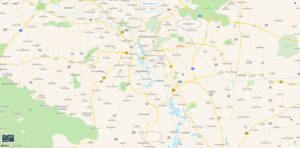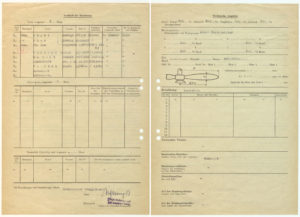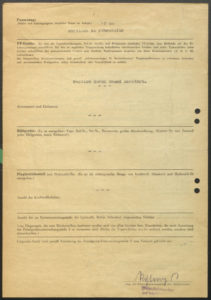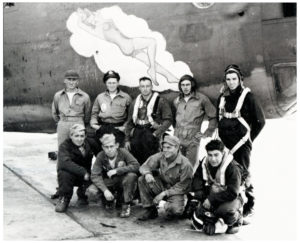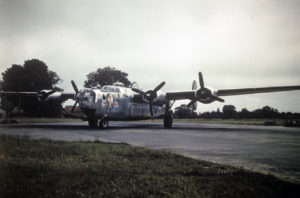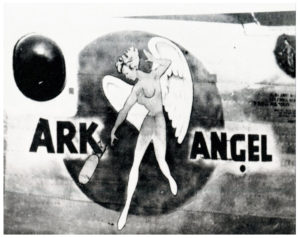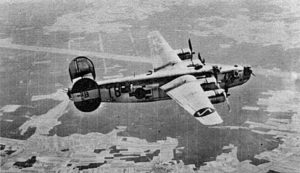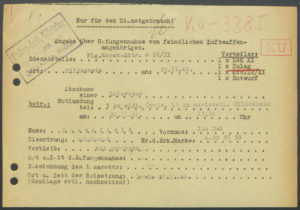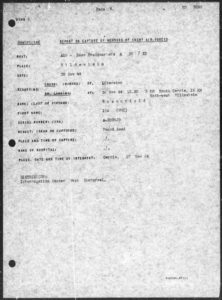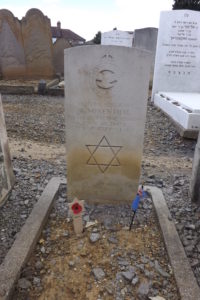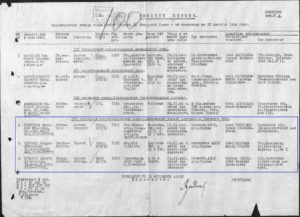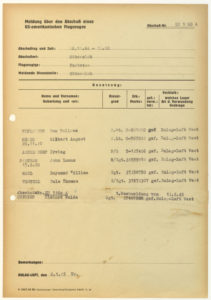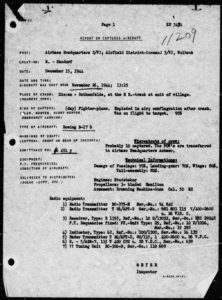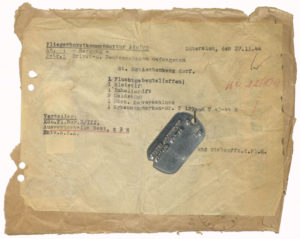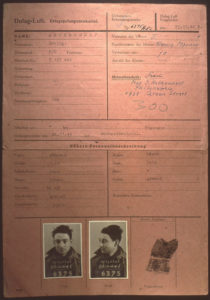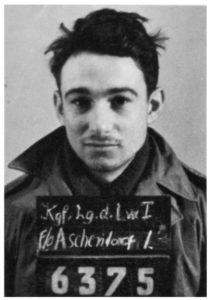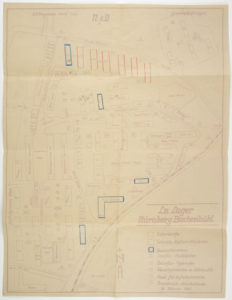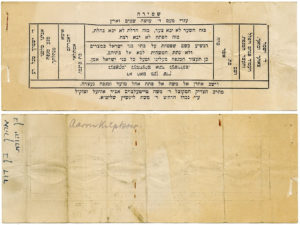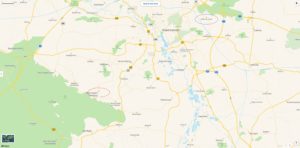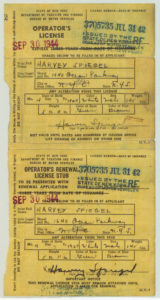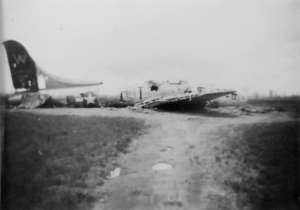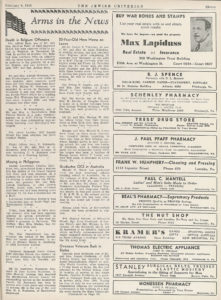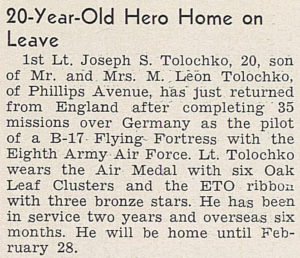[Created a couple of years ago – ! – this post has been updated, with the inclusion of maps, as well as new documents and illustrations. I also removed the two images of MACR 10140 (covering the loss of Lt. Davis’ B-24), due to the (non-typically) poor quality of the digital (Fold3) versions of these documents, replacing them with a simple list of the names of the plane’s crew members.]
Lieutenant Richard H. Davis, from Belle Harbor, New York, was the subject of several news items during his military service. Three such items appeared in The Wave (Rockaway Beach) on July 22, 1943, and May 18 and August 24, 1944, and covered his military training and deployment to England.
On April 12, 1945 the sad news item covering Lt. Davis’ death – during an operational mission over Europe on October 18, 1944 – appeared on The Wave’s front page. This announcement was accompanied by a photograph of the Lieutenant standing before a B-24 Liberator bomber.
The article (found and accessed via Thomas M. Tryniski’s fantastic FultonHistory.com website) is presented below.
____________________
Lt. Richard H. Davis Killed In Action
Lieutenant Richard H. Davis, 20-year-old son of Mr. and Mrs. Paul Davis of 156 Beach 134th Street, who was reported missing October 18, 1944, was killed in action on that date in the European Theatre of Operations, his parents were notified by the War Department last week.
Lieutenant Davis was a navigator on a Liberator B-24 bomber with the 8th Air Force. He enlisted in the Army Air Corps in 1942 and was called in February, 1943. He received his training at Selman Field, Louisiana, and few to England in July, 1944, and attended combat training school in North Ireland. While there he underwent a period of intensive training in high altitude bombing procedures used in the European Theatre of Operations.
Lieutenant Davis was the holder of the Air Medal with two Oak Leaf Clusters.
He was a graduate of Public School 114 and of Far Rockaway High School, class of 1942. Before enlisting in the service, he was active in Boy Scout Troop 112 and in the Beth-El Players Guild, having appeared in “It Can’t Happen Here,” “Out of the Frying Pan,” and “Our Town.”
Before enlisting, Lieutenant Davis was a Government Civil Service employee in Manhattan.
The B-24 serving as the backdrop in the photograph appears, based on the shape of the forward fuselage and bombardier’s window, to have been a modified “D” version Liberator, with a Consolidated A-6 tail turret (installed by the Army Air Corps Oklahoma Modification Center) replacing the conventional D-version bombardier’s “greenhouse”. Given that such planes were assigned to the 8th Air Force’s 479th Anti-Submarine Group, the image probably was taken after Lt. Davis’ arrival in England, while he and his crew were undergoing additional training in that country.
By way of example… The images below (Army Air Force Photographs 76491AC / A11896 and 76493AC / A11897, respectively) showing 479th ASG aircrews at Saint Eval, England, in 1943. The crew in the former image are anonymous, while the caption of the latter image states that the pilot is Lt. Hill.
____________________
A month after the article in The Wave, on May 12, 1945, The New York Times carried an obituary for Lt. Davis, which included a portrait taken when he was an Aviation Cadet.
Bombing Plane Navigator Lost in Europe Last Fall
 Lieut. Richard H. Davis, navigator of a Liberator bomber and holder of the Air Medal with two Oak Leaf Clusters, who was reported missing last Oct. 18, was killed on that date in the European theatre, according to word received by his parents, Mr. and Mrs. Paul Davis of 156 Beach 134th Street, Belle Harbor, Queens.
Lieut. Richard H. Davis, navigator of a Liberator bomber and holder of the Air Medal with two Oak Leaf Clusters, who was reported missing last Oct. 18, was killed on that date in the European theatre, according to word received by his parents, Mr. and Mrs. Paul Davis of 156 Beach 134th Street, Belle Harbor, Queens.
Lieutenant Davis, who was 20 years old, entered the Army Air Forces in February, 1943. He was attached to the Eighth Air Force.
____________________
Nearly a year after the mission of October 18, 1944, The Wave – on October 25, 1945 – carried mention of a memorial tribute held in Lt. Davis honor at Temple Beth El, on Friday evening, October 19, 1944.
Another year – October 20, 1946 – and Lt. Davis’ was mentioned in the “In Memoriam” section of the New York Times obituary page.
____________________
Lt. Davis was and his crew were assigned to the 68th Bomb Squadron of the 44th Bomb Group, otherwise known as the “Flying Eight-Balls”.
Missing Air Crew Report 10140 covers the loss of Lt. Davis and his crew in B-24H Liberator 42-50381 (WQ * K), piloted by 1 Lt. Julian H. Dayball. As described in detail in Will Lundy’s 44th Bomb Group Roll of Honor and Casualties, during a mission to chemical works at Leverkusen, Germany, there was apparently a mid-air collision between WQ * K, and B-24H 41-28944 (NB * D, “Flying Ginny“) of the 67th Bomb Squadron, which was piloted by 1 Lt. Michael Bakalo. This occurred over Belgium in severe weather, while their formation was returning to the 44th’s base at Shipdham, England.
The planes crashed 1 kilometer from Petegen, near Deinze, in Belgium, the general location indicated by the red oval in the map below.
Of the 21 men aboard the two aircraft there emerged two survivors – waist gunners S/Sgt. George J. Encimer and S/Sgt. Cecil L. Scott – who were both seriously injured after parachuting from Flying Ginny.
Lt. Davis’ crew, none of whom survived, comprised:
1 Lt. Julian H. Dayball – Pilot
High Mill, Mo.
F/O Robert L. Phillips – Co-Pilot
Washington
S/Sgt. Arthur August Steinke – Gunner (Nose Turret)
Snohomish, Wa.
S/Sgt. Ivan W. Fink – Flight Engineer
Juniata, Pa.
Sgt. Edward Paul Sicard – Radio Operator
Turners Falls, Ma.
Sgt. John J. Shea – Gunner (Tail)
Dubuque, Ia.
Sgt. Wilbert L. Couvillion – Gunner (Right Waist)
Baton Rouge, La.
Sgt. Malcolm R. Smith – Gunner (Left Waist)
Washington, D.C.
S/Sgt. Conrad Raymond Bettley, Jr. – Radar Observer
Worcester, Ma.
Richard Davis is buried at Jefferson Barracks National Cemetery, St. Louis, Mo. (Section 82, Collective Grave 114-115.) Other crew members buried at the same site include Lt. Dayball; right waist gunner, Sgt. Couvillion; tail gunner, Sgt. Shea; flight engineer, Sgt. Fink; nose gunner, Sgt. Steinke, and radio operator, Sgt. Sicard. The image below – from FindAGrave contributor “Remo” (the late Bobby Jean “Remo” Remelius) – shows their collective grave marker.
 Lieutenant Davis was awarded the Air Medal and two Oak Leak Clusters.
Lieutenant Davis was awarded the Air Medal and two Oak Leak Clusters.
His name never appeared in the postwar publication American Jews in World War Two.
____________________
Some (some) other Jewish military casualties on Wednesday, October 18, 1944 (1 Cheshvan 5705), include…
Killed in Action
– .ת.נ.צ.ב.ה. –
United States Army Air Force
Herman, Bernard L., 2 Lt., 0-817213, Co-Pilot, Purple Heart
Mr. and Mrs. Benjamin C. and Molly Herman (parents), 7301 Park Heights Ave., Baltimore, Md.
Place of burial unknown
Baltimore Sun 2/6/45
American Jews in World War II – 140
Stern, Jerome J., T/Sgt., 16105797, Radio Operator, 1 Oak Leaf Cluster, Purple Heart
Mrs. Celia Stern (mother), 1656 47th St., Brooklyn, N.Y.
Place of burial unknown
Casualty List 2/6/45
American Jews in World War II – 455
Lieutenant Herman and T/Sgt. Stern, members of the 67th Bomb Squadron, 44th Bomb Group, 8th Air Force, were crewmen on “Flying Ginny”, the loss of which is covered in MACR #15241.
Witkin, Leonard, 2 Lt., 0-701359, Navigator, Purple Heart, Ten Missions
United States Army Air Force, 8th Air Force, 44th Bomb Group, 68th Bomb Squadron
Mr. and Mrs. Jacob and Sylvia S. Witkin (parents), 2851 Baxter Ave., New York, N.Y. / 980 Simpson St., Bronx, N.Y.
Born 9/2/21
MACR 9654, B-24J 42-50596, “Flak Magnet”, “WQ * O”, Pilot – 1 Lt. Edward C. Lehnhausen, 9 crewmen – no survivors
Wellwood Cemetery, East Farmingdale, N.Y. – Section B, Block 45, Row 6, Grave 7R, Division North
American Jews in World War II – 474
Wasserman, Gerald M., 2 Lt., 0-2060421, Navigator, Purple Heart, Four Missions
United States Army Air Force, 8th Air Force, 390th Bomb Group, 568th Bomb Squadron
Mrs. Ruth W. Wasserman (wife), 1020 E. 7th St., Brooklyn, N.Y.
Mr. Samuel Wasserman (father), c/o Ferber, 732 N. 26th St., Allentown, Pa.
MACR 9484, B-17G 43-38189, “Powerful Katrinka / Bugs Bunny”, “CC * M”, Pilot – 2 Lt. Donald T. Drugan, 9 crewmen – 4 survivors, Luftgaukommando Report KU 3131
Jefferson Barracks National Cemetery, St. Louis, Mo. – Section 84, Grave 235-239 (Buried 10/16/50)
American Jews in World War II – 465
(See more about the Drugan crew below, specifically pertaining to the account of Lt. Harry W. Love’s survival…)
United States Army (Ground Forces)
Fiegelman, Joseph, PFC, 33603325, Purple Heart, 1 Oak Leaf Cluster
United States Army, 90th Infantry Division, 358th Infantry Regiment
Mr. and Mrs. Samuel and Dora Fiegleman (parents), Lawrence and Louis (brothers), 520 S. Washington Ave., Scranton, Pa.
Dalton Jewish Cemetery, Dalton, Pa.
American Jews in World War II – 520
Gordon, Oscar, Pvt., 31406940, Purple Heart
United States Army, 85th Infantry Division, 359th Infantry Regiment
Mrs. Sarah Gordon (mother), Bridgeport, Ct.
Florence American Cemetery, Florence, Italy – Plot D, Row 10, Grave 19
American Jews in World War II – 64
Marcus, Herbert, Pvt., 32802905, Purple Heart
United States Army, 35th Infantry Division, 320th Infantry Regiment
Mr. Abraham Marcus (father), 4701 12th Ave., Brooklyn, N.Y.
Cambridge American Cemetery, Cambridge, England – Plot F, Row 7, Grave 102
Casualty List 11/28/44
American Jews in World War II – 387
Canada
Hurwitz, Samuel Moses, Sgt., D/26248, Distinguished Conduct Medal, Military Medal
Canada, Royal Canadian Armoured Corps, Canadian Grenadier Guards, 22nd Armoured Regiment, No. 3 Squadron
Captured 10/18/44; Died of wounds 10/20/44
Mr. and Mrs. Harry and Bella Hurwitz (parents); Archie, David, Esther, George, Harry, Ian, and Max (brothers and sisters), 6093 Park Ave., Montreal, Quebec, Canada
Born Lachine, Quebec, Canada, 1/28/19
Bergen-op-Zoom Canadian War Cemetery, Noord-Brabant, Netherlands – 9,F,1
The Jewish Chronicle 1/12/45, 6/29/45
Canadian Jews in World War II – Volume I – 46, 52
Canadian Jews in World War II – Volume II – 34
Sergeant Hurwitz was the subject of the lengthy story “Some Never Die”, published by the Canadian Grenadier Guards (cover shown below) which was later incorporated into the Sergeant’s biography in Part I of the 1947 publication Canadian Jews in World War II – Decorations. The image below, of the front cover of Some Never Die, is from Shelly Reuben’s November, 2013 essay “Big Footsteps – Sgt. Samuel Moses Hurwitz“, at patch.com, which was originally published in The Evening Sun of Norwich, New York. Ms. Reuben’s story includes six other photos of Sergeant Hurwitz as well as members of his family (unfortunately, none of these photos have captions). Her account, which includes recollections of the Sergeant’s life and last days from veterans who’d served with him in combat, is as detailed as it is deeply felt, for Sergeant Samuel Moses Hurwitz was her uncle: “Uncle Moe”.
This image of Sergeant Hurwitz, via Operation: PictureMe, is from his FindAGrave biographical profile…
…while this image Sgt. Hurwitz’s matzeva, also at FindAGrave, is from Astrid. The Hebrew inscription at the base of the stone can be translated as: “Here lies the young man Shmuel Moshe son of Khayim Avraham ha _____ [covered by flower] Hurwitz, may the Lord avenge his blood, from Montreal, Canada, [probably dates, partially obscured by flower].
Czechoslovakia
Lobel, Alois, Pvt., B/1196 (Died in France, at Dunkirk)
Czechoslovakia, 1st Armoured Brigade
Born Czechoslovakia, Rajec, okres Diein; 5/23/21
La Targette British Cemetery, Neuville-St, Vaast, Pas de Calais, France – M,13
(The above information about Pvt. Lobel was originally obtained via the Ministry of Defence and Armed Forces of the Czech Republic website. I don’t know if this information is still openly accessible.)
Zide v Ceskoslovenskem Vojsku na Zapade (Jews in the Czechoslovak Army in the West) – 246
England
Freedman, Israel, Pvt., 4038716
England, Pioneer Corps
Mr. and Mrs. Lewis and Rachel Freedman (parents), 15 Mayland St., Stepney, London, E1, England
Born 1914
East Ham (Marlow Road) Jewish Cemetery, Essex, England – Block U, Grave 21
The Jewish Chronicle 10/29/44
We Will Remember Them – Volume I – 086
This image of Pvt. Freedman’s matzeva is via Mike Ganly.
Poland
Kolsberg, Mieczyslaw, Cpl., Poland, Mazowieckie, Otwock, Otwock Hospital
9th Infantry Regiment
Mr. Karol Kolsberg (father)
Born 1904
Andriolli Street Cemetery, Otwock, Mazowieckie, Poland
Jewish Military Casualties in the Polish Army in World War II – Volume I – 38
Soviet Union
Red Army
U.S.S.R. (C.C.C.Р.) – Red Army [РККА (Рабоче-крестьянская Красная армия)]
Borshchevskiy, Mikhail Borisovich – Junior Lieutenant [Борщевский, Михаил Борисович – Младший Лейтенант]
Machine Gun Platoon Commander [Командир Пулеметного Взвода]
93rd Rifle Division, 266th Rifle Regiment
Born 1924; Kiev, Ukraine
Mother: Olga Romanovna Golotgor
Buried Moravian Banovina, Yugoslavia, 1 km west of Krusevac
Sherman, Aleksandr Abramovich – Junior Lieutenant [Шерман, Александр Абрамович – Младший Лейтенант]
Machine Gun Platoon Commander [Командир Пулеметного Взвода]
9th Guards Mechanized Corps, 30th Guards Mechanized Brigade
Born 1924; Belaya Tserkov, Ukraine
Mother: Anna Sherman
Buried in Hungary, southern outskirts of Beretyesamar
Diskant, Isaac, Pvt. (Died at Silute, Lithuania)
16th Lithuanian Rifle Division
Mr. Moshe Diskant (father)
Born 1922
Road to Victory – Jewish Soldiers of the 16th Lithuanian Division – 293
Gruzd, David, Sgt. (Died at Silute, Lithuania)
16th Lithuanian Rifle Division
Mr. Gutman Gruzd (father), Pvt. Chaim Gruzd (brother)
Born 1915
Road to Victory – Jewish Soldiers of the 16th Lithuanian Division – 294
Shamis, Monia, Lt. (Died at Priekule, Latvia)
16th Lithuanian Rifle Division
Mr. Shmuel Shamis (father)
Born 1912
Road to Victory – Jewish Soldiers of the 16th Lithuanian Division – 304
____________________
Wounded in Action
United States Army (Ground Forces)
Dienstman, Samuel, Pvt., 33778251, Purple Heart (Mediterranean Theater)
(Captured on January 27, 1944, and escaped)
Mr. Raphael and Anne Dienstman (parents); c/o Morris Dienstman, 404 W. Rittenhouse St., Philadelphia, Pa.
Pvt. Benjamin Dienstman and Morris Dienstman (brothers), 1533 Devereaux St., Philadelphia, Pa.
Born Pa., 1924
The Jewish Exponent 1/12/45
Philadelphia Inquirer 1/7/44
Philadelphia Record 1/7/44, 2/29/44
Philadelphia Bulletin 1/8/45
American Jews in World War Two – 517
Via FultonHistory, here’s the Philadelphia Inquirer’s January, 1944 article about Pvt. Dienstman’s capture and escape from German forces. Unfortunately, I’ve been unable to identify his military unit.
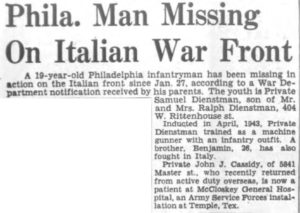
This photograph of Samuel Dienstman appeared in The Philadelphia Bulletin on January 8, 1945.
____________________
Prisoners of War
United States Army (Ground Forces)
Nadelman, Jack W., Sgt., 32822644, Purple Heart, 1 Oak Leaf Cluster
United States Army, 30th Infantry Division, 119th Infantry Regiment
(Also wounded ~ 9/22/44)
POW at Stalag 6G (Bonn)
Mr. and Mrs. Charles and Mary (Feber) Nadelman (parents), 58 E. 1st St., New York, N.Y.
Born N.Y., 1/6/26
Casualty Lists 11/22/44, 4/1/45, 7/6/45
American Jews in World War II – 398
Peters, Abraham, Pvt., 42087543, Purple Heart
United States Army, 30th Infantry Division, 119th Infantry Regiment
POW at Stalag 2B (Hammerstein)
Mrs. Doris F. Peters (wife), 1664 Ocean Parkway, Brooklyn, N.Y.
Casualty Lists 6/6/45, 6/15/45
American Jews in World War II – 405
Strauss, Arthur, PFC, 32648586
United States Army, 1st Infantry Division, 18th Infantry Regiment
POW at Stalag 2B (Hammerstein)
Mrs. Klara Adler (sister), 140 Vermilyea Ave., New York, N.Y.
Casualty List 6/18/45
American Jews in World War II – Not Listed
United States Army Air Force
The date of October 18, 1944 became notable for 2 Lt. Harry Wilson Love (0-777006) of the United States Army Air Force – mentioned above in regard to Lieutenant Gerald Wasserman – in three ways: It was his 21st birthday, fourth combat mission, and signified his survival under extraordinary circumstances:
A bombardier, Lt. Love was one of the four survivors of “Powerful Katrinka / Bugs Bunny” / “CC * M”, B-17G Flying Fortress 43-38189, piloted by 2 Lt. Donald T. Drugan. An aircraft of the 568th Bomb Squadron of the 8th Air Force’s 390th Bomb Group, the plane was struck by flak near Koblenz during the 390th’s mission to Kassel, and, exploding in mid-air, fell to earth in the vicinity of Leutersdorf. The incident is covered in Luftgaukommando Report KU 3131.
Born on October 18, 1923, he was the son of Samuel Edgar Wilson and Fannie (Genov) Love of 1717 Parkview Ave. (and 1590 E. 172nd St.?) in the Bronx,
Lt. Love was eventually interned at Stalag Luft III, Sagan, Germany. Though his name appeared in a Casualty List released on March 7, 1945, it was absent from the 1947 compilation American Jews in World War II. He passed away on March 27, 2016.
This image of Harry, from Ancestry.com (I don’t know if it’s still available there) shows him as an Aviation Cadet, immediately recognizable as such by the two-bladed propeller on his cap.
From MACR 9484: A/C #189 was hit by flak 6 miles South of Koblenz at 1245 hours. Hit was between #3 and #4 engines which set his right wing on fire. No. 4 engine was knocked out. A/C stayed level for 10 seconds, then made a slow right turn losing altitude, and trailed formation for about ½ mi.es. A/C then lost right wing, going into flat spin and disintegrating. One chute was observed, with possibly 4 delayed jumps.
From translated document in Luftgaukommando Report KU 3131: On 18 oct 1944, 1148 o’clock an American bomber was downed by Flak at Leutersdorf / 9 km northwest of Neuwied (71 PP 3). Type, factory No., and markings not to be confirmed because craft exploded in an altitude of 3000 m and the fragments are scattered around widely. Damage 99%. Crew bailed out and is fugitive. – (KU 3131). (Note… The digital version of KU 3131, accessible via NARA, is incomplete.)
These two Mapple Apps Apple Maps maps show the location of Powerful Katrinka’s loss. The upper map shows Neuwied in relation to Aachen, Cologne, Koblenz, and Frankfurt am Main…
…while this map shows Neuwied and Leutersdorf, which lie on the east bank of the Rhine River.
In 1985, Harry Love’s account of his singular (emphatic understamtent) experience was published in Volume II of the 390th Bomb Group Anthology. His story follows…
Birthday “Blow Out”
by Harry W. Love
Bombardier, 568th Bomb Squadron
My story begins like so many other bomber crews… at 0400 hours 18 October 1944.
As per schedule, the crews are awakened; the quick wash-up; off to the mess hall for the usual chow-down; back to barracks for completion of dress, storing of personal papers and finally, off to the briefing room. As rhetoric will have it, this is basically the routine for any bomber crew in the 8th Air Force, flying out of England.
My story, however, departs from the traditional version espoused by so many others on 18 October 1944… It was my 21st birthday. My attitude, no different from any other 21 year old; I was happy, had a great crew and festivities were planned for that evening when we returned from the bombing mission.
At the briefing, we received our instructions. Our mission was to Koblenz, Germany. (Considerably less difficult or dangerous we thought than Berlin, Regensburg, Augsburg, or so many others.) During the briefing session, the members of the crew contemplated no unusually heavy problems. At the completion of the general briefing, the pilots, navigators and bombardiers parted ways for individual briefings. We then were driven to our assigned aircraft.
The plane we originally had been assigned to was the Silver Meteor. It was, however, taken out of service for this particular mission because of heavy damage it sustained two days prior, on a mission to Cologne. Therefore, we were reassigned to a brand new B-17G. It was a truly magnificent looking craft as we approached it that morning.
Inspection of armament loading procedures (which was my responsibility as Bombardier) was conducted and before too long, it was takeoff time. Reflecting back I feel a few words are deemed necessary regarding my Pilot, Donald Drugan. He was a masterful, highly prestigious, military man and competent in all aspects of his assigned field. Our Co-Pilot, John Mohn, was very astute, tolerant and somewhat more pacific than Donald Drugan. Our Navigator, Gerald Wasserman, a Brooklyn boy, was very dedicated to his job and an asset to our crew.
Take off was uneventful. The weather was clear (although dark at the time of departure). We found our assigned positions at the prescribed altitude. Not too long thereafter, the British Coast was behind us.
The order to “check your guns, and fire your guns” was given. The response traditionally heard was, “All guns firing properly and in order.”
We approached the coast of Europe at approximately 0830 hours. Our target Koblenz was still an hour and a half away. We encountered no enemy fighters en route, and the flak was light.
The bomb run over the target was considered very successful. Upon making our turn off the bomb run (after release of bombs), we then headed in a northwesterly direction to meet up with the balance of the Wing which could be seen some 15-20 miles away. At this time, it was quite apparent that we were some 5 or 6 minutes behind schedule in our rendezvous with the Wing for our trip back to England. This necessitated our lead crew to change course some degrees further to the north which brought us over a portion of the Ruhr Valley. On approaching this particular area, some 5 or 10 miles from our rendezvous, we began to pick up massive concentrations of flak fire. One of the first bursts came within 100 yards of the front of our plane. This was followed by 5 or 6 more immediately, thereafter, each one closer than the preceding one. It seemed that we were well tracked down below by the antiaircraft crews. At this time, I announced to the crew that the bursts were directly in line… the Pilot, in accord, confirmed my communication.
Some 2 or 3 seconds later, we received a hit in the nose of the plane directly above the chin turret leaving a hole some 15-20 inches in circumference. I immediately back tracked away from my chin gun position and took up a station to the right (which was the cheek gun). The cyclonic rush of air that came through was impossible to control. I recall vividly the Navigator stating over the intercom, “Nobody will know how close the Bombardier came to buying it… the bursts of flak came through within inches of his right leg.”
The antiaircraft gunners on the ground weren’t finished tracking our plane, for at that instant we received a direct hit in one engine (starboard side) with shocking impact. Massive vibrations developed and fumes and smoke filled the plane. The pilot, without hesitation, pulled out of formation, and attempted to put out the flames within that particular engine by sides-lipping the plane.
Upon looking at the right wing, it was obvious that the damage thereto, was extensive. The entire right wing was oscillating up and down some 20-30 degrees. On seeing this, I assisted the Navigator Gerald Wasserman in putting on his chest pack. As Bombardier, I always wore my backpack throughout the entire mission.
I called to the Pilot in the customary technique… “Bombardier to Pilot, do you have any instructions?” He replied, “Bombardier, I hear you.” Looking back at the wing again I could clearly see the oscillation increasing. The Engineer, Sgt. Parker, dropped down from his position to our station with the Navigator between us. I instructed the Engineer to open the escape hatch located directly in front of him. He complied immediately. I again called to the Pilot asking if there were any further instructions regarding possible bail out. The Pilot, once again replied, “Bombardier, I hear you,” but no instructions followed.
Looking out at the wing again (which was oscillating even more), it was obvious to me that the wing could not stay on much longer. At this point, firmly believing the alarm bell and intercom were no longer operating, I directed the Engineer to bail out. He (Parker) looked up to the Pilot for some expression of guidance…he did not receive any. He then looked back at me and the Navigator who was directly in front of me. At this critical point (with little or no time for conversation), a mandated determination had to be directed and carried out. The Engineer would have to bail out of the plane first, the Navigator second and then myself. I, in a loud tone (after removing my oxygen mask), ordered the Engineer to bail out… again he hesitated. I then began to physically push the Navigator in that direction stating, “We have to go, the wing is coming off.” The Navigator looked at me with quite an acceptable (and understandable) look of doubt, and shook his head. At that instance, the wing came off!
It is apparent that with one of the wings off of a B-17, it will not fly. Our plane began to plummet down in a spiraling, leafy fashion to earth. At this point, I would assume we were in the neighborhood of 20-22,000 feet. Quite instantaneously, all within the craft were seemingly welded to their specific positions. I was flung against the starboard cheek gun slamming my neck against it in a rigid fashion, unable to move a muscle due to the powerful centrifugal force exerted during the spiraling effect. At this moment, I vividly recall thinking of one thing, and one thing only… “What will Mom say or feel when she hears about me being killed in action?” There was no question or doubt in my mind that I was to meet “my maker” in a matter of moments. There was no possible chance for anyone to successfully escape this situation.
Approximately two or three seconds later, there erupted a tremendous, all-encompassing explosive force, I felt my entire body weight being lifted by an unknown force. I was literally catapulted through the air, head first and out the front plexiglass nose of the aircraft. The plane had exploded. The gas tanks (I am assuming), from the other wing or in the body of the craft, had been ignited by the flak we took. Luckily I did not black out. I was alert and fully cognizant of the entire situation. I knew instantly that I was free from the aircraft. I had the foresight, however, not to pull the rip cord immediately. As I began to fall to earth, I could clearly see burning debris from our aircraft. Far to the left, a chute opened; shortly thereafter on my right, another chute; and then a few seconds later, still another chute opened. This chute (the latter), perhaps opened too soon, and as fate would have it, part of the burning debris struck his chute as it opened. Which crew member it was, I could not identify. I held my rip cord with a firm grasp for what seemed to be hours, but I’m sure it was only a second or two before making a move. I saw clear areas around me. I then pulled the cord and to my utter surprise, I felt no jerk, as anticipated. My most prevalent thought at this time was, “The parachute must have been torn from my back when I was blown from the front of the plane.” I looked up and there it was … blossoming beautifully above me. Perhaps the reason for not feeling the impact of the chute opening, can be attributed to the mental trauma I had so recently experienced, i.e., being blown out of the aircraft. My thought at this time, “My God, I’m going to be safe. I’m floating down to earth.”
At this juncture, everything began to go black, or more accurately, red. I now realized I could not see. I placed my hands over my eyes, wiped them and realized I did not come away from this situation unscathed completely. I was bleeding profusely from head wounds received when I was blown through the front plexiglass of the craft. I also realized that my shoes that were tied to my parachute harness were not there. They had been snapped, or torn, off when I was blown out of the aircraft.
On descending, I could see a forest area and remembered some of the instructions we received concerning means of generating control over the parachute. I was able to tug at the harness, thus controlling the direction of the chute so that my landing would be between some very large fir trees. I landed on a 45-degree slope of a hill. Not being proficient in parachute landings, I came down extremely hard, striking both legs in a rather awkward position, that later would prove to give me untold pain and discomfort. The impact of landing so hard and abruptly, caused one of my legs to collapse on the base of my spine.
Reflecting back to military orders and instructions, concealment of the chute after landing was of the utmost concern. I picked the chute up as quick as I possibly could and dug and scratched a large hole in a leafy area where I buried it under branches, twigs, etc. I began moving in a westerly direction but soon, thereafter, collapsed. The injuries I had sustained were not as minor as I initially thought. Both of my ankles were swollen out of proportion, and the bleeding from my skull wounds were now in a hemorrhaging state. I took stock of what medications I had and treated myself with sulfur [sulfa] for my scalp wounds and bandaged them the best I could. I then constructed make-shift crutches and again attempted to move on. As my arduous journey continued, I further realized I was experiencing pain at the base of my neck. Later I found that my 2nd Lieutenant bar was bent completely in half. Something most assuredly had struck it with a great impacting force to have caused it to bend. The object which had struck the metal bar so precisely, had to have been metal; the 2nd Lieutenant bar undoubtedly saved my life. I sustained a massive hematoma on my neck where the bar had originally been affixed to my collar.
I placed the time of my landing at 1230 hours. I continued to move on through the afternoon. I traveled for several hours in a westerly direction as best I could, and rested part of the night in a thickly wooded area. I did not know for sure how many of the crew got out, but I had seen two chutes at a distance. Later I was informed that a fourth airman had in fact gotten out. There were only four survivors from our B-17G.
The following day, during the early hours after dawn, determined and still limping, I continued to move on. The wooded area that concealed me began to echo with a terrifying sound; that of track dogs. The area where I had descended was flooded with civilian and Wehrmacht troops.
I was finally detected and captured by the aforementioned group of people, at approximately 0900 hours on the 19th of October 1944. I was taken to a town (to the best of my recollection, Oberursel) where my imprisonment began.
Some weeks later, during which time I spent a week of interrogation procedures in Dusseldorf, I had the heartwarming pleasure of seeing three of the enlisted members of my crew. The Tail Gunner, Conwell, related to me that he was blown out of the tail section. Raymond Hutt was blown out of the Waist Gunner’s compartment and the Radio Operator, Ledford, was blown out of the top section of the craft’s radio compartment. I was further informed that the Ball Gunner, Stevens, had not emerged from the ball nor did he have his chest pack on at the time the wing disengaged itself from the aircraft. Out of a crew of nine, only four survived.
After spending about eight months in prison camps, Stalag Luft 3, Sagan and Moosburg, I was liberated by Patton’s Third Army on 29th April 1945 and returned home in May of that year.
October 18th, Nineteen Hundred Forty-Four, was my day of infamy, it too was my Birthday … my day of Rebirth.
This Is My Story.
Control Tower Log for 18 October 1944 shows one aircraft MIA
0715: All mission a/c off except 325-T – hydraulics out – ship stuck off edge of r/w and field will be u/s (Ed: unserviceable) for landing a/c until at least 1030 – possibly later.
0930: 831-C aborted with #3 feathered, prop run away. Will circle until 325 is cleared.
1130: 325 off r/w. Ship 007-M (Lewis) lost a piece of 325 plexiglass nose on t/o. No damage to 007.
1131: 831 C landed. (Ellis)
1542: All a/c returned except 189-M (Drugan)
J.H. Stafford 1 Lt. S.C.
____________________
On August 9, 2002, Harry spoke about his wartime experiences, and other aspects of life, in an interview available at the New York State Military Museum.
When Harry passed away on March 27, 2016, he was the last survivor of the crew of Powerful Katrinka / Bugs Bunny. He is buried at New Montefiore Cemetery in West Babylon, New York.
____________________
A photograph of Donald Drugan’s crew (contributed by FindAGrave contributor Patootie), taken during training in the United States, is shown below. The names of the crew members are listed beneath the image.
Sgt. Jurl Thomas Parker (Flight Engineer – KIA)
Tamaha, Ok.
Ardennes American Cemetery, Neupre, Belgium – Plot D, Row 3, Grave 5
Sgt. Willis T. Ledford (Radio Operator – survived – Died July 3, 1996)
Cleveland, Ga.
Hoschton City Cemetery, Hoschton, Ga.
Sgt. Raymond LaVerne Hutt (Waist Gunner – survived – Died Nov. 19, 2008)
Tecumseh, Ne.
Tecumseh Cemetery, Tecumseh, Ne.
Sgt. Robert Stevens (Ball Turret Gunner – KIA)
Long Beach, Ca.
Ardennes American Cemetery, Neupre, Belgium – Plot A, Row 38, Grave 47
Kaiser (Waist Gunner – did not fly on mission of October 18)
Sgt. Cleon Conwell (Tail Gunner – survived – Died April 6, 2006)
Monticello, In.
Buffalo Cemetery, Buffalo, In.
Front (L – R)
2 Lt. Donald Terrance Drugan (Pilot – KIA)
Portland, Or.
Ardennes American Cemetery, Neupre, Belgium – Plot D, Row 1, Grave 47
2 Lt. Jonathan V. Mohn (Co-Pilot – KIA)
Portland, Or.
Ardennes American Cemetery, Neupre, Belgium – Plot D, Row 5, Grave 30
2 Lt. Gerald M. Wasserman (Navigator- KIA – (See more above…)
Brooklyn, N.Y.
Jefferson Barracks National Cemetery, St. Louis, Mo.
2 Lt. Harry Wilson Love (Bombardier – survived – Died March 27, 2016)
Bronx, N.Y.
____________________
Here are four pages from the Missing Air Crew Report (#9484) for Powerful Katrinka / Bugs Bunny comprising postwar reports about the plane’s loss by Lt. Love and Sgt. Conwell. Because of the nature of the plane’s loss – a mid-air explosion – there was little that could definitively be said about the five crewmen who were killed.
Here’s Harry Love’s account…
When my chute opened, after I was blown out, I saw 2 other parachutes floating down – actually there were 3 besides my own.
Pieces of the plane were falling all around my chute, truthfully there was nothing left of the plane to speak of.
The out look for the (5) members of my crew that are still listed as missing, seems very bad. I would say after 16 months that they were killed when the plane exploded.
If I can be of any further assistance, or any additional information is needed, please let me know. I’ll comply immediately.
Kindly acknowledge by mail, any thing concerning the members of my crew – or upon receiving these forms.
Sincerely,
Harry W. Love, 2nd Lt.
And here’s Sgt. Conwell’s…
I am sorry to say that there is very little that I can tell to shed light on this mystery, because of my position as tail gunner I depended upon the intercom system to keep in touch with the rest of the crew. Therefore I could not see anything that happened in the forward part of the plane.
The Bombardier Love & Radioman Ledford came together by chance at the transit camp at Wetzlar Germany. But could not come to any conclusions about the rest of the men.
____________________
Here’s the “header” page of Luftgaukommando Report KU 3131, which, typical of most such reports compiled by the Germans for American aircraft losses from early 1944 onwards, includes such data as general type of aircraft, location and time of the plane’s loss, information about the crew where known and established (such as surname and given name, rank, serial number, and status – prisoner, wounded, hospitalized, or killed), and the date upon which the document was completed. It can be seen that KU 3131 covers only the four survivors of Powerful Katrinka / Bugs Bunny.
____________________
Also from Ancestry.com (don’t know if it’s still available there), here’s a close-up of Harry Love’s POW identification portrait (“mug-shot”, as it were) from his German Prisoner of War “Personalkarte”, which was probably taken within a few days of his capture.
And, from KU 3131, his dog-tag. Note that the tag has been stamped with the single letter “P”, which would ostensibly indicate that its bearer was of the Protestant religion. Though unfortunately I never had the opportunity to interview Harry Love about his experiences, it would have been interesting to have asked him if he ever pondered the implication of being captured by the Germans (let alone other aspects of being a Jewish soldier during WW II). I think his dog-tag indirectly answers that question, though such an answer brings forth another question: Harry certainly received his tog-tag months before his assignment to his own crew, as well as – in turn – his crew’s assignment to the 8th Air Force, and thus, service in the European Theater of War. So, did his choice of the abbreviation “P”, well in advance of the knowledge or certainty that he would be assigned to the European Theater of War, suggest a longstanding, unarticulated concern about the implications of being a Jewish prisoner of war?
Though Harry’s dog-tag would not suggest as much, his name still appeared in the National Jewish Welfare Board’s Bureau of War Records card index of American Jewish servicemen, part of the data from which formed the basis of the state-by-state compilation (Volume II) of American Jews in World War II. For other examples of NJWB Index Cards, see the three such cards filed for Major Milton Joel.
____________________
This image (WW II Army Air Force Photo 3200 / A45511) is captioned, “Lt. Maurice A. Bonomo, Bombardier, 333 W. 86th St., New York City, 18 daylight missions; holds Air Medal with two Oak Leaf Clusters”. The picture gives an excellent representative view of the the bombardier’s position in a B-17 Flying Fortress (specifically, a B-17G Flying Fortress).
Lt. Bonomo, viewed as if looking forward from the navigator’s position, is facing the bombardier’s control panel. Above the control panel can be seen a nose-mounted “flexible” port M-2 Browning 50 Caliber machine gun, with its ammunition feed chute hanging to the right. (Another flexible M-2 Browning, out of view of the photograph, is mounted within the right side of the nose.) The remote control for the aircraft’s Bendix chin turret (housing two M-2 Brownings) is visible – in its stowed position – to the right of Lt. Bonomo. In front of Lt. Bonomo is the bombardier’s plexiglass nose “bubble”, which – despite variations in design among different versions of the B-17 – is so visually characteristic of the Flying Fortress.
Given that Lt. Bonomo is not (!) wearing his oxygen mask, and is directly touching the control panel without (!) gloves (neither of which would be advisable at altitude…) this is almost certainly a “posed” photograph, taken while the B-17 was on the ground.
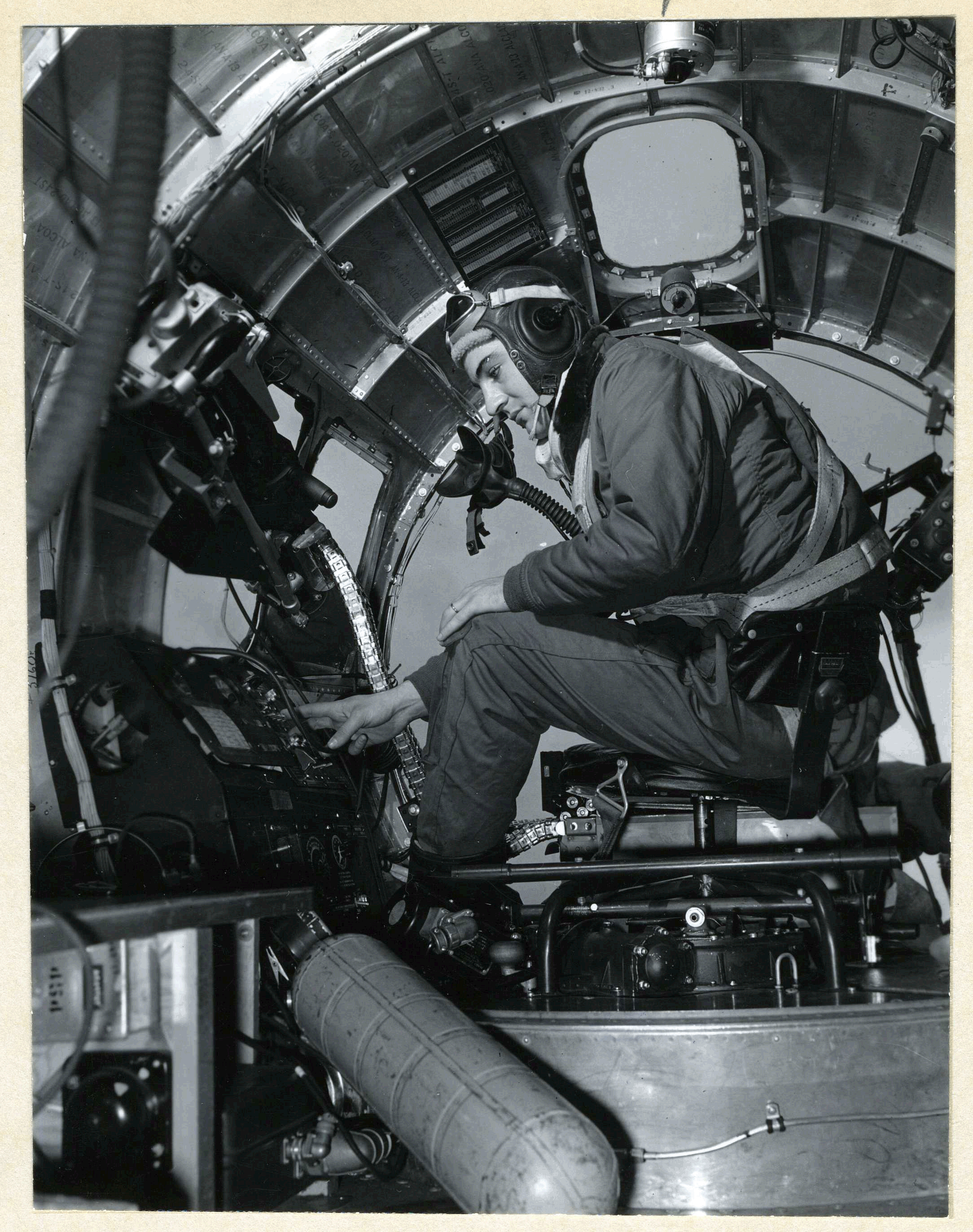 Though the date of this photograph is unknown, what is known is that Lt. Bonomo, a member of the 401st Bomb Squadron, 91st Bomb Group, became a prisoner of war on July 20, 1944, during a mission to Leipzig, Germany. On that date, he was a member of 1 Lt. Arthur F. Hultin’s crew in B-17G 42-102509, which was lost due to anti-aircraft fire. Fortunately, all 10 crewmen survived as POWs. The plane’s loss is covered in MACR 7274 and Luftgaukommando Report KU 2560, the latter document being unusually detailed in its description of the plane.
Though the date of this photograph is unknown, what is known is that Lt. Bonomo, a member of the 401st Bomb Squadron, 91st Bomb Group, became a prisoner of war on July 20, 1944, during a mission to Leipzig, Germany. On that date, he was a member of 1 Lt. Arthur F. Hultin’s crew in B-17G 42-102509, which was lost due to anti-aircraft fire. Fortunately, all 10 crewmen survived as POWs. The plane’s loss is covered in MACR 7274 and Luftgaukommando Report KU 2560, the latter document being unusually detailed in its description of the plane.
Maurice (serial number 0-754720), the husband of Janet A. Bonomo, of 333 West 86th Street, in New York, was imprisoned in North Compound 2 of Stalag Luft I, in Barth, Germany.
His name appeared in Casualty Lists published on December 13, 1944, and (as a liberated POW) on June 15, 1945, and can be found on page 281 of American Jews in World War Two.
References
Books
Blue, Allan, The B-24 Liberator – A Pictorial History, Charles Scribner’s Sons, New York, N.Y., 1975
Davis, Larry, B-24 Liberator in Action (Aircraft No. 80), Squadron / Signal Publications, Inc., Carrollton, Tx., 1987
Dublin, Louis I., and Kohs, Samuel C., American Jews in World War II – The Story of 550,000 Fighters for Freedom, The Dial Press, New York, N.Y., 1947
Kulka, Erich, Zide Československém Vojsku na Západé, Naše Vojsko, Praha, Czechoslovakia, 1992
Leivers, Dorothy (Editing and Revisions), Road to Victory – Jewish Soldiers of the 16th Lithuanian Division, 1941-1945, Avotaynu, Bergenfield, N.J., 2009
Lundy, Will, 44th Bomb Group Roll of Honor and Casualties, Green Harbor Publications, 1987, 2004
Meirtchak, Benjamin, Jewish Military Casualties in the Polish Armies in World War II: II – Jewish Military Casualties in September 1939 Campaign – Jewish Military Casualties in The Polish Armed Forces in Exile, World Federation of Jewish Fighters Partisans and Camp Inmates: Association of Jewish War Veterans of the Polish Armies in Israel, Tel Aviv, Israel, 1995
Richard, Wilbert H.; Perry, Richard H.; Robinson, William J., The 390th Bomb Group Anthology – Volume II, 390th Memorial Museum Foundation, Inc., Tuscon, Az., 1985
Canadian Jews in World War II – Part I: Decorations, Canadian Jewish Congress, Montreal, Quebec, Canada, 1948.
Canadian Jews in World War II – Part II: Casualties, Canadian Jewish Congress, Montreal, Quebec, Canada, 1948

